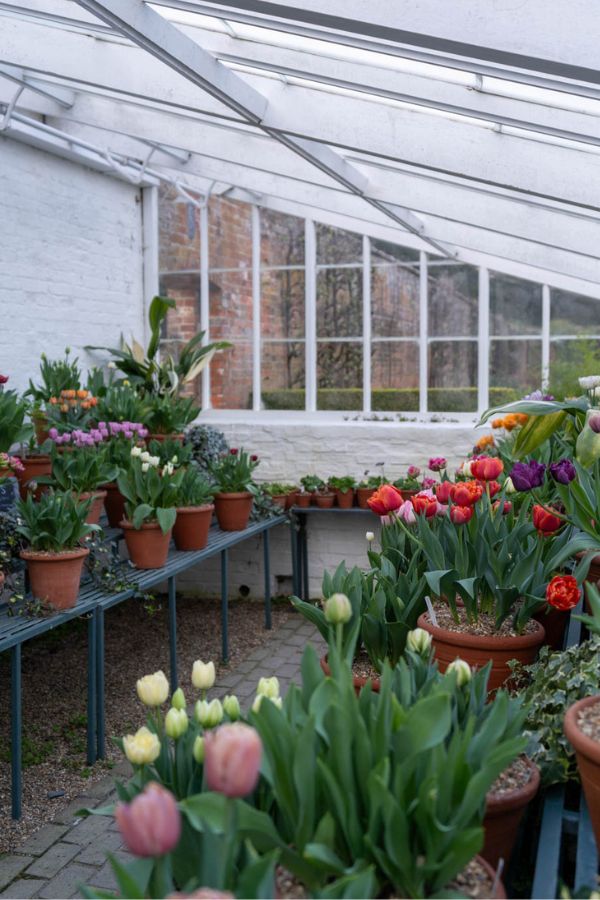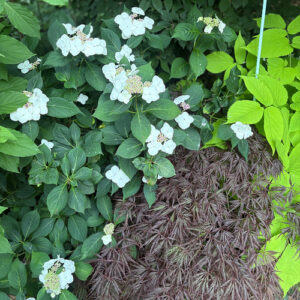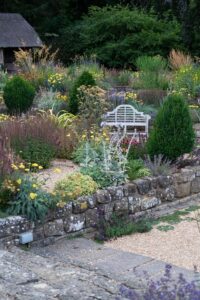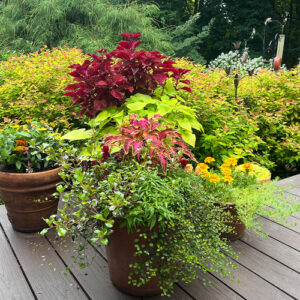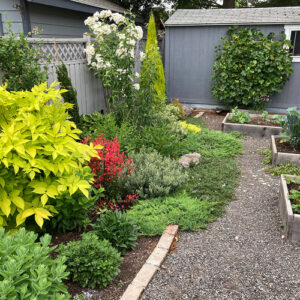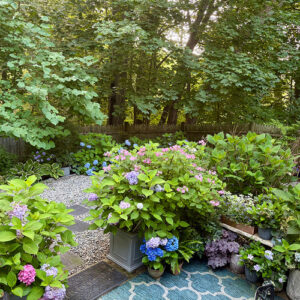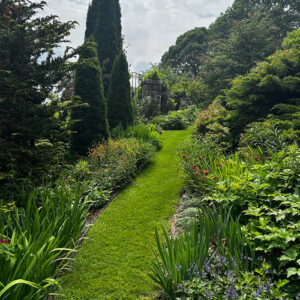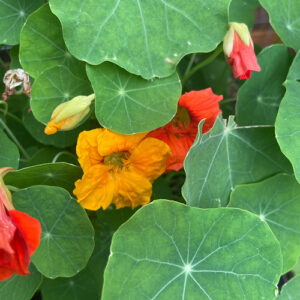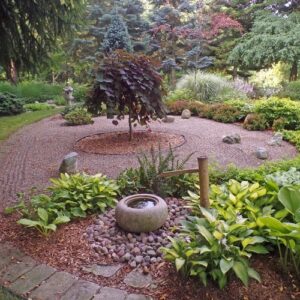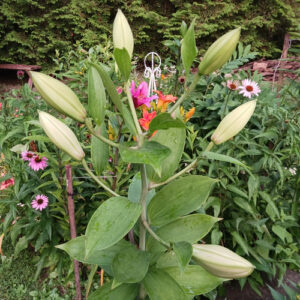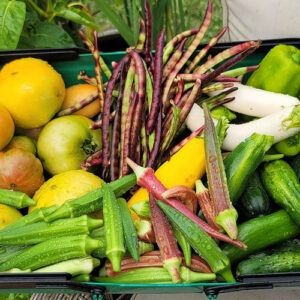April 11th, 2025 Posted In: Sheds/Sanctuaries
Greenhouse gardening can stretch the flowering season, giving you blooms up to six weeks earlier than usual.
And although a full size greenhouse can also be a living space – a haven away from the world – you can get the same growing benefits from lean-to greenhouse shelving, cloches and cold frames.
Tom Brown is the author of The Greenhouse Book and head gardener at the stunning West Dean Gardens in Sussex. Over a year, Tom set up and used every kind of greenhouse structure in his own middle-sized garden. These ranged from a full-size hobby greenhouse to lean-to shelving, cold frames, and even simple cloches.
With the advent of AI, it’s easy to find an answer to almost any question. But if you don’t know where that answer comes from or whether it has been tried out in real life, you may not be much the wiser. That’s why Tom has tried everything he writes about In The Greenhouse Book. And he shares what really works, even in the smallest space.
So I asked him to answer some of the most common questions about choosing and using a greenhouse.

Buy The Greenhouse Book here (affiliate link, see disclosure) or here. The book is photographed by Jason Ingram, who also has written an excellent book on How to Photograph Gardens.
Choosing a greenhouse – what is best for a small or middlesized garden?
The first question anyone asks is ‘what size of greenhouse should I choose?’
Tom says that you should choose the largest size of greenhouse you can manage for your space or budget!
‘I wish I’d bought a bigger greenhouse,’ is probably the only real regret you will ever hear from a greenhouse owner.
However, if you don’t have space, you can get the benefits of greenhouse growing on a smaller scale by using cloches, cold frames or lean-to shelving mini greenhouses.


Cloches and cold frames can be used for small-space greenhouse gardening. Top shows a cloche from Elho made to fit a window box. Above are the cold frames at West Dean. They could be described as low walled boxes with a glass ‘lid’.
Are mini or lean-to greenhouses effective?
While writing The Greenhouse Book, Tom installed every possible size of greenhouse structure in his own garden.
So he bought an inexpensive set of mini greenhouse shelves and set them against a south-facing wall. ‘I was able to grow everything in the mini greenhouse shelves that I grew in the larger greenhouses,’ he says. (Obviously, in smaller quantities!).
He used the mini greenhouse shelves for growing seeds and over-wintering plants. ‘Then in summer, the shelves can be removed so I used them for growing tomatoes.’


This mini greenhouse shelving is in a garden created entirely from pots. These are ideal for small spaces or if you’re renting and want to take everything with you. See more of this garden in rented gardens!
Should I choose glass or polycarbonate panels?
Tom says that glass panels break more easily, so you may prefer polycarbonate if you have a children or pets. ‘But glass lets in a little more light and they’re easier to repair when they do break.’
Having assembled all the greenhouses for the book in his own garden, he admits to being ‘terrible at DIY – I’m not ashamed to admit that I broke several panes of glass while installing them.’
But he found it relatively easy to find a glass shop who could cut him new panels to size. ‘If you’re buying a greenhouse second-hand – and that’s the reality for many people – then it may well be missing a few frames or frames can break in transit. So glass would be easier to replace.’
What’s the best position for a greenhouse in my garden?
Tom says that the first thing to consider is access from the house, especially in winter. ‘If your greenhouse is tucked away, you won’t visit it as often. And also if you have to cross the lawn to access it, you’ll wear a path in the lawn. Incorporate it in the design of your garden.’
Avoid placing greenhouse structures – lean-to shelving, cloches or cold frames – under the shade of trees or in the shadow of walls or buildings.


This beautiful lean-to greenhouse at West Dean Gardens is on a north-facing wall, so is used for plants that are happy with bright shade rather than needing hours of direct sunlight.
And, although you can place a greenhouse against a north-facing wall ( south-facing in the Southern hemisphere), it will limit what you can grow in it. ‘Here at West Dean we have a lean-to greenhouse on a north facing wall. We use it for ferns and for growing tulips in winter/spring and fuschias in summer because they’re happy with some shade. But seedlings could get leggy if grown in a greenhouse structure against a north-facing wall.


The cooler north-facing lean-to greenhouse at West Dean is used for fuchsias, lilies and pelargoniums in the summer.
What flowers grow best in a greenhouse?
Most people think of greenhouses as places to grow veg. And many veg, such as cucumbers, chillies, aubergines and tomatoes need the extra shelter and warmth of a greenhouse in summer to ripen properly. The Greenhouse Book has lots of veg growing advice, but I wanted to know more about the flower growing side of a greenhouse.
For example, can you grow flowers in a greenhouse all year round? Tom says that greenhouse growing is best for extending your flower year rather than year-round flower growing.
Use the greenhouse for veg during the hot summer and for flower growing in autumn, winter and spring. ‘Many flowers will find a greenhouse too hot in the summer,’ he says.


Many people keep exotic plants in pots in the garden or on a terrace during the summer, then over-winter them in a greenhouse in winter.
This makes the most of your greenhouse in winter. ‘Don’t use it just as a storage space!’ he says.
Tom’s favourites include stocks and sweet peas, which he plants as seeds in the autumn. The young plants and seedlings then sit in the greenhouse, apparently dormant over winter. But their root system is growing stronger all the time, so when the longer daylight hours of spring and summer arrive, they’re ready to go out into the garden and flower around six weeks earlier.
You get a longer flowering season this way because you can also grow the same flowers from seed starting in spring, and these will flower later. This two-sowing way of growing sweet peas, for example, can give you blooms for months on end.
You can sow many seeds in autumn, including ammi major, cerinthe, California poppies and cornflowers. See Sowing Seeds – An Expert Guide.
And Charlotte Denne of Kent Wildflowers recommends sowing wildflowers in trays and pots to overwinter for planting out in the spring. See How to Grow Wildflowers.
Can I grow cut flowers in a greenhouse?
Very much so, says Tom. His wife is a florist. He says that as soon as The Greenhouse Book was finished, she took over most of various growing spaces to grow cut flowers.


Tom Brown with the flowers he’s grown in his own home greenhouse – he says that a greenhouse means you get flowers earlier and they’re protected from the weather so they’re perfect blooms.
Tom recommends growing florists’ anemones, ranunculus and bulbs in the greenhouse. You’ll get perfect flowers. ‘The winter weather can damage blooms, so growing these in a greenhouse means you have perfect cut flowers.’


There’s no damage from wind or weather on these tulips – they’ve been grown in a greenhouse at West Dean.
Are there any flowers or flowering plants I should NOT put in a greenhouse?
Tom says that you can grow any plant in a greenhouse. Just be aware of the greenhouse climate and whether it is suitable for that particular plant.
How do I use a greenhouse for overwintering tender plants?
Tom suggests moving chrysanthemums, pots of spring bulbs, cannas, fuchsias, pelargoniums, anemones and ranunculus into an unheated greenhouse during the winter to protect them from frost.
The plants won’t grow much, but their root systems will be ready to spring into growth about six weeks earlier than usual when the longer days arrive.
Tom says that there are two important aspects to greenhouse gardening in winter.
Firstly, don’t over-water your plants! During the winter, when the plant is barely growing, it isn’t using up much water. So water can sit in the pot and rot the roots.
Secondly, clean your greenhouse windows to let every bit of light through.
Tom’s home greenhouses didn’t have any fixed heating. ‘Many people are either renting or can’t afford to run electricity and water through the garden to the greenhouse, so I didn’t heat my home greenhouses.
However, he suggests using bubble wrap to protect plants (or the greenhouse windows) if it gets very cold. And you can also raise the temperatures just above freezing with a small portable heater or even a candle in a terracotta pot.
How do I stop a greenhouse from overheating in summer?
There are three ways to stop a greenhouse from overheating in summer. Firstly, at West Dean, Tom’s team paint most of the greenhouse windows with a chalk paint to reduce temperatures in the summer.
‘We use a roller because they’re big greenhouses,’ he says. ‘But when I was doing the book, I tried to use a roller on the smaller domestic size greenhouse and it made such a mess! So for hobby greenhouses, I’d suggest using a big paintbrush. Use a washable chalk paint on the outside of the panes. You may have to top it up if it’s rained off.’


Most of the greenhouse glass at West Dean is painted to keep greenhouses from over-heating on hot days. Tom says to use a brush not a roller on smaller, hobby greenhouses.
Then in the autumn, you’ll need to scrub it off with a stiff brush and water. ‘I won’t say it’s quick,’ says Tom. ‘You do need a bit of elbow grease.’
Secondly, ventilation is key in any greenhouse. Tom advises listening to your instincts. ‘If you go into your greenhouse and it feels too hot, then it probably is.’ Open the door or doors and lift windows for ventilation.
And on a very hot day, Tom also splashes water on the floor to cool the greenhouse down!
How do I keep pests and diseases under control?
Pests and diseases can be an issue in a greenhouse as it is a confined space. Tom says that it’s a good idea to have a variety of plants, because a pest or disease will spread through a mono-culture (rows of the same variety of plants) very quickly.
He also recommends keeping a close eye on the plants and acting quickly. If you see some spider mite or aphids, wipe them off with your finger as soon as you see them.
He also uses biological controls that won’t damage other species, such as SB Plant Invigorator Pesticide & Natural Pest Control.
But you also need a few pests in any environment in order to get pest predators, he says. The old style of greenhouse gardening was to say ‘if it flies, it dies!’ and the greenhouse had to be a very sterile place where nothing lived except for the plants you were growing.
Today, gardeners are generally more relaxed about a little bit of mildew or a few pests. They’ll just remove the offending foliage or wipe off the pests without feeling they have to spray everything in the whole greenhouse.


What are the best space-saving tips for a small greenhouse?
Tom advises uses staged greenhouse shelving to maximise usable space in a greenhouse. You need to stay aware of how shelving affects the light, however. The shelves at West Dean have slatted shelving and are staged at up to four different levels.
You can cram a greenhouse, says Tom. If you want to prioritise growing in a greenhouse and don’t want to leave a space for a table or chairs, you can leave just a very narrow path in the middle so that you can walk up and down.
He also says that keeping a greenhouse tidy will save space. And because gardening tools can be sharp or heavy, that’s also safer.


Staged slatted shelving at West Dean Gardens makes the most of the growing space and the light. But check that shelving isn’t taking light away from seedlings or they will get leggy and bend towards the sun.
If you want to use your greenhouse for potting up, you don’t necessarily need a permanent potting bench. Tom uses a large tray as a potting bench in his greenhouse at home so that he’s not taking up permanent space with it.
If you want chairs and a table inside the greenhouse then the table can double as a potting bench. When not being used for potting up, you can use it for cups of tea or even a book.
Visit West Dean Gardens
West Dean Gardens are one of the UK’s most famous restored historic gardens. They’re attached to the much-loved West Dean College of Arts, Design, Craft & Conservation. As well as doing diplomas, online courses, week or weekend courses and post-graduate degrees, you can also do courses in horticulture, garden design and gardening.
Tom himself teaches The Gardening Year At West Dean, a beginner gardening course. Other practical gardening skills courses he teaches include Growing Cut Flowers and Summer Fruit Tree Pruning.
West Dean Gardens are open to the public for 362 days a year, although opening times vary so check the website.
Pin to remember answers to common greenhouse gardening questions
And do join us. See here for a free weekly email with more gardening tips, ideas and inspiration.


